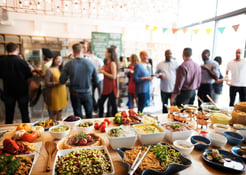Samantha Markiewicz first entered the digital marketing space in 2011 when social media was still a relatively new frontier for restaurants.
Instagram was just one year old. Snapchat was created that year. TikTok was five years from existence. Suffice it to say that a lot has changed about how restaurants use social media today.
Markiewicz is vice president of digital operations for national hospitality communications company Bread and Butter. This role has given Markiewicz an inside look at restaurant social media trends as they have shifted and evolved. And from this vantage, Markiewicz is not surprised that restaurants have come to depend on effective social media strategies to succeed in the current business environment.
“I remember a very successful restaurant owner looking at me and saying, ‘No one wants to look at pictures of food’,” said Markiewicz. “I was just like, ‘Hold my beer. I’ll show you.’”
Over the next decade, Markiewicz assembled a team that now works with more than 50 restaurants and over a dozen hotels and vendors of consumer packaged goods. With Markiewicz at the helm of their expanding digital operation, Bread and Butter didn’t just follow the top restaurant social media trends, but led the way. And today, she told us, having a strong social media game is just as essential for restaurants as having a website.
10 Restaurant Social Media Trends You Need to Know
In a conversation with Markiewicz, we learned a lot about how restaurants use social media as a key part of their broader business strategy. Here are some of the key insights Markiewicz shared about today’s top restaurant social media trends:
1. Catering to generational consumer shifts
Younger consumers are increasingly comfortable managing restaurant experiences entirely through the use of social media platforms and profile pages.
"Millennial and Gen Z audiences are using social media as a proof point for your product – people can understand your concept without ever visiting your website," Markiewicz noted. "Plus, integrations between platforms, like OpenTable with Instagram, have made it so I no longer have to click to a brand's URL to make reservations.”
Restaurants are recognizing this change in consumer behavior, and, according to Markiewicz, many are “definitely shifting to more spend on social media and a greater emphasis on building their own communities and audiences.”
2. Converting more sales on-platform
This greater spend is also translating into more direct revenue. One of the leading restaurant social media trends today is deeper integration between social media platforms and e-commerce tools.
"A greater emphasis [has] been put on making sure digital sales components are set up from the beginning – how are we going to do business when our four walls are closed, or how are we going to expand upon the business we have?" Markiewicz explained. "A big focus of my team has been putting together a strategy to build an audience and convert them to those delivery channels.”
3. Finding the right media mix
The right media mix may depend in part on your particular audience. The right set of social media platforms for a renowned high-end restaurant will likely be different than the ideal mix for a national fast-casual chain.
“Fast-casuals attract the audience using TikTok – that up-and-coming generation who’s just starting to have their first jobs and make their own purchasing decisions," said Markiewicz. "They're spending most of their time on TikTok, whereas someone that's going to a $200 seated dinner might not be there yet. They're searching Instagram or looking at the Google Business account.”
Markiewicz also noted that she advises clients on how to leverage legacy Facebook followers even as the platform loses relevance as a marketing tool; points clients toward LinkedIn largely for recruitment and executive networking; and generally tells clients to steer clear of X (formerly Twitter).
That said, based on how restaurants use social media today–with a heavy emphasis on visual content–Markiewicz said that “Instagram is still really the number one for restaurants.”
4. Prioritizing video content
The heavy emphasis on visual content is also the reason behind this social media trend. Today, video content gains the most traction with audiences.
“Instagram has kind of forced it upon people with their push of reels. It’s essential," observed Markiewicz. "And I don’t think video’s going to go away because of this arms race between TikTok and Instagram.”
This trend doesn’t diminish the importance of heaving effective, evocative, and appetizing photo content. Markiewicz pointed out that “I do have all of our clients get professional photos. There are going to be PR opportunities where they’re necessary.”
Still, the rising impact of engaging video content is among today’s leading restaurant social media trends.
If your restaurant is still learning how to create effective video content, Markiewicz offered this helpful tip:
“I tell restaurant operators quite frequently–document; don’t create. Something that might feel really simple to you, like shopping at a farmer’s market, is great visual content. Hold your phone over those tomatoes, baby!”
5. Cross-posting on all your platforms
Once you’ve selected your social media mix and learn how to develop engaging content, make sure you’re also leveraging the full power of both these startegies. Markiewicz expressed the importance of posting new content across all appropriate platforms simply “because most of the time there’s just such a need for content.”
That said, it’s also important to understand and adjust for the fact that each social media platform calls for a specific tone, cadence, and posting protocols. That is why, said Markiewicz of channels like Instagram and TikTok, “I have separate content strategies for both platforms. My most successful clients on TikTok are posting seven to 10 times a week, sometimes more. Then for Instagram, the reels live so much longer in the newsfeed. I can get engagement for anywhere from two to four days, and then even more if the reel picks up again as a trend. I’m posting two or three reels per week.”
Even as you cross-post, understand the unspoken rules of engagement for each platform and adjust accordingly.
6. Creating an image of transparency
This item speaks to one of the biggest shifts in how restaurants use social media today. Historically, social media outlets have served as a tool for brand management and image control. That’s still true today. However, Markiewicz noted that today’s consumer also expects far greater transparency from their brands. Social media platforms have become a preferred channel for meeting this expectation.
“People want to see what restaurants are really like," said Markiewicz. "And because this new generation is so technologically savvy, you can't really hide anything. If you have a restaurant where your food is terrible, but you have, let’s say, a beautiful Instagram wall, people are going to call you on it. People have lost fear of putting their real thoughts online, and you need to be prepared to handle that.”
7. Getting real with your customers
In addition to greater transparency, restaurant social media trends are pointing toward far greater authenticity. Markiewicz suggests that you should be using your social media channels to show the inner-workings of your restaurant.
“Have you seen that show The Bear on Hulu?” asked Markiewicz. “That inside grittiness – I think we’re going to see more of that on restaurant pages. I just moved back to northwest Oregon, and one of my favorite restaurants here is called Eem, and I love their social media because it’s kind of chaotic, and you can feel just a slight bit of frenzy, in the best way. Their posts super outperform.”
8. Engaging actively and effectively
While the leading restaurant social media trends here suggest an ever-shifting landscape, there is one tried and true rule to succeeding. Engagement is still everything.
“It's super important – not just for the guest that’s posting about their experience, but even more so for the guest who's deciding if they want to have that experience. It’s why I always tell my restaurants we need to respond to negative and positive Google reviews," Markiewicz explained. "The next person who’s looking wants to see if the restaurant cares. If the restaurant can say something like, ‘Yeah, we messed up on your order. I'm sorry about that. We're going to give you a free one,’ that’s super powerful.”
9. Collaborating with other brands
Markiewicz also emphasized the importance of leveraging strategic partnerships to grow your audience. Joining with popular entities that have their own social media presence is providing one of the most effective restaurant social media trends today.
“One thing that’s super powerful is brand collaborations," Markiewicz mused. "Like if Sweetgreen teams up with Lululemon. I work with a hotel, but they have a restaurant in Napa, and we do wine dinners, which sounds so 2015, but every single time we market a wine dinner, it sells out, and we get a huge influx of followers just from that winery’s audience. People love a brand collaboration.”
10. Choosing the right social media marketing platform
Of course, not every restaurant operator has the time or desire to take on all of these social media initiatives in-house. And make no mistake about it–crafting an effective social media management strategy takes work.
Fortunately, enlisting the support of a third-party social media marketing platform is also among the current restaurant social media trends, as it takes some of the responsibility off your plate. Platforms come with a wide range of features, customer support packages, and price points. To learn more, check out our index of the industry’s top social media marketing platform vendors.
Additional reporting by Grace Dickinson.





